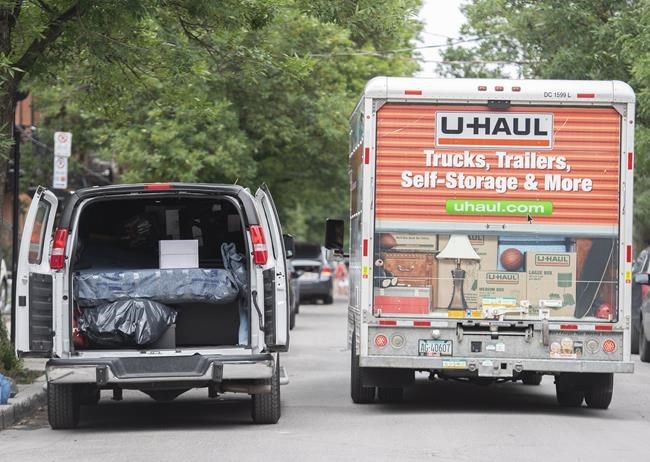Your parents are finally downsizing after 40 years in the same house. You want to help, but where to even start?Â
It’s a dramatically different world from the last time they moved, in terms of finding quality services, researching options and comparing prices. This is where children can play a key role for their parents, especially those who may not be as internet-savvy,says Bill VanGorder, chief advocacy and education officer for the Canadian Association of Retired Persons.
“Often, adult children are more familiar with researching things online, have networks that they can check with, and are able to maybe dig a little deeper,” he says.Â
“People get older, they don’t always access information (online), they may use the internet for email and for some entertainment, but they don’t understand the ways of finding good information.”
Significant costs and stress come with downsizing — so research and legwork can ensure a smooth transition to a new lifestyle in a smaller space, VanGorder says. Adult children might also have friends or spouses who have gone through similar experiences with their own parents and can share those best practices and referrals.
Moving and downsizing companies
Finding reputable moving services is a major concern for CARP’s 225,000 members, VanGorder says.
CARP works with the Canadian Association of Movers to share information and resources on its website, including warnings about moving scams. The moving industry is unregulated, the CARP website points out, so anyone can claim to be a mover.
VanGorder recommends using local CARP chapters and seniors organizations to find moving companies that specialize in serving older people. He says the process can be “very different for older people than it is for younger people, who are doing it for different reasons.”
If it’s a big move, a solo parent, or an adult child isn’t available to help, downsizing companies offer the full service: organizing and packing, donating and selling items, junk removal and the move itself.
Cindy Beaudet, owner of Destinations Seniors Downsizing in Calgary, says a reputable service should have workers’ compensation insurance to protect clients against lawsuits in case an employee is injured during a move.Â
“A lot of (downsizing) companies don’t,” she says.
Testimonials, references and reviews are a must, and Beaudet says detailed quotes ensure every service and cost is upfront. Her company’s quotes will have around 20 line items, with explanations of everything from elevators to travel time.
Another critical detail, if you want to recoup some costs by selling some possessions — ask downsizing companies if they have relationships with local dealers.
Selling possessions
Estate sales typically expect a minimum value of $25,000 in sellable items, Beaudet says, which is not realistic for many clients. Her company has relationships with dealers who buy in bulk, including furniture, antiques, coins and banknotes, jewelry, silver cutlery and original art.
If you’re looking into a downsizing company, ask for a track record of sales or dealer relationships.
“I have an art dealer,” Beaudet says, “plus I have a website I use, it’s called Art Price. So I’ll go into somebody’s house and I’ll just type the artist in and it tells me … the last 100 paintings that were sold, the valuation, I measure them and everything like that. So I can give them an idea — if it goes to auction, this is what it’s going to get.”
If you’re downsizing yourself, you can find dealers to offer a sum for the entire contents left in a house, VanGorder says.
There are also always donation options, including non-profits such as Habitat for Humanity, second-hand stores, religious groups, and newcomer organizations.
In terms of selling privately, via Facebook Marketplace or other local options, VanGorder says it might be fruitful if there’s a family member who is already active in selling on such websites. But generally, it’s a tough racket.
“It can be a lot of work, and it depends on what you have,” VanGorder says. “But things aren’t usually worth as much to other people as they are to us. So that’s often disappointing.”
Once these possessions are sold or donated, Beaudet says adult children can help with acquiring new, compact furniture pieces to fit a smaller space. For those moving into a senior residence, for instance, around 650 square feet is a common size of a unit, so seating and accent tables will need to be sized down.
Storage
Beaudet is blunt about the value of long-term storage.
“I'm sorry, waste of money,” she says.Â
It’s better to donate or sell items now, she says, and adult children should get their parents on-board, helping them let go emotionally of possessions they cannot bring along.
“Typically, our clients are 86 and older,” she adds. “They don’t even access the stuff that they put into storage in the basement at the seniors’ home.”
For downsizers who might feasibly use items in the future, VanGorder advises asking storage companies for seniors discounts.Â
Older buildings with storage space are often cheaper than the new builds that are popping up, he adds. But parents shouldn’t use storage with the expectation their adult children want all their stuff.
“One of the greatest disappointments people have is that they think they’ve got all these wonderful things that their kids are going to want,” VanGorder says. “Kids don’t want them.”
Adult children should let their parents know that upfront, they could save significant costs on storage, and perhaps earn them some cash if the items can be sold.
This report by The Canadian Press was first published Jan. 23, 2024.
Nina Dragicevic, The Canadian Press
Note to readers: This is a corrected story. A previous version misstated the number of CARP members.




